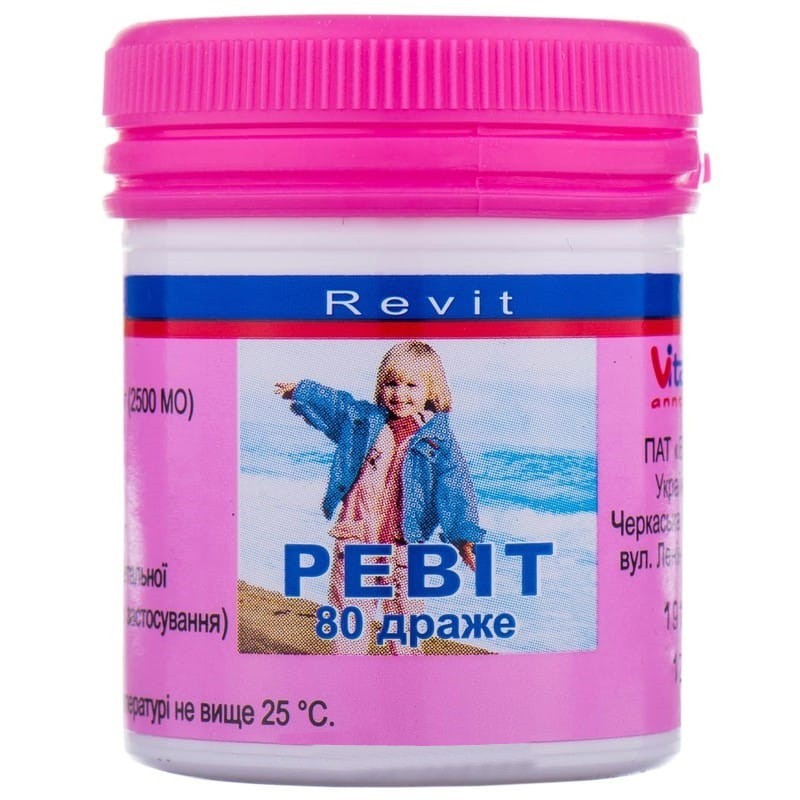



 Secure and encrypted payment processing
Secure and encrypted payment processing We ship to over 40 countries including the USA, UK, Europe, Australia and Japan
We ship to over 40 countries including the USA, UK, Europe, Australia and Japan Guaranteed refund or reship if you haven't received your order
Guaranteed refund or reship if you haven't received your orderDragee "Revit" is prescribed as a prophylactic and therapeutic agent in conditions accompanied by an increased need for vitamins - increased physical and psychological stress, especially under adverse environmental conditions; recovery period after illness; to increase the bodys resistance to infectious and colds.
1 tablet contains (active substances):
Excipients: starch syrup, sugar, peppermint oil, yellow wax, sunflower oil, talc.
Hypersensitivity to the components of the drug, nephrolithiasis, fructose intolerance, glucose-galactose malabsorption syndrome, hypervitaminosis A, thrombosis, tendency to thrombosis, thrombophlebitis, diabetes mellitus, chronic glomerulonephritis, severe kidney disease, childhood history of sarcoidosis, childhood copper metabolism, 3 years
The drug is taken orally, 10-15 minutes after a meal.
For adults, for the purpose of prevention, prescribe one tablet 2 times a day, for the purpose of treatment - two tablets 3 times a day.
Pregnant women are recommended to use:
For the purpose of prevention, prescribe for children from 11 years old one dragee per day.
For therapeutic purposes, children from 3 to 10 years old should be prescribed 2 tablets a day, from 11 to 14 years old - 3 tablets a day.
The duration of use is determined by the doctor individually and can be 1-2 months.
According to the doctors prescription, it is possible to increase the recommended doses.
Use during pregnancy is possible after consulting a doctor with strict adherence to the recommended doses.
To eliminate vitamin deficiency in pregnant women and mothers who breast-feed, specialized complexes of vitamins with minerals should be preferred.
For children under 3 years of age, the use of the drug is contraindicated.
There are no data on the effect on the reaction rate when driving vehicles or working with other mechanisms, but possible side effects should be taken into account.
Symptoms: increased side effects of the drug.
Treatment: symptomatic therapy.
Ascorbic acid is well tolerated. It is a water-soluble vitamin, its excess is excreted in the urine. However, with prolonged use of vitamin C in large doses, inhibition of the function of the insular apparatus of the pancreas is possible, which requires monitoring the state of the latter. An overdose can lead to changes in the renal secretion of ascorbic and uric acids during acetylation of urine with a risk of precipitation of oxalate calculi. The use of the drug in high doses can lead to vomiting, nausea or diarrhea, which disappear after its withdrawal.
When using the drug in recommended doses, adverse reactions are very rarely possible, which are listed below.
On the part of the immune system: in individuals with hypersensitivity, allergic reactions are possible, including anaphylactic shock, Quinckes edema, hyperthermia, rarely - bronchospasm in individuals with hypersensitivity to vitamins A, C, group B vitamins.
On the part of the skin and subcutaneous tissue: skin rash, urticaria, itching, redness of the skin, eczema.
From the gastrointestinal tract: dyspeptic disorders, nausea, vomiting, diarrhea.
From the side of the nervous system: headache, dizziness, increased irritability, drowsiness, sweating, sleep disturbance, increased fatigue.
From the liver and biliary system: impaired activity of liver enzymes.
From the endocrine system: damage to the insular apparatus of the pancreas, glucosuria and impaired glycogen synthesis until diabetes mellitus appears.
From the side of the kidneys and urinary system: crystalluria, damage to the glomerular apparatus of the kidneys, the formation of urate, cystine and / or oxalate calculi in the kidneys and urinary tract, renal failure.
On the part of the blood system and lymphatic system: thrombocytosis, erythrocytopenia, neutrophilic leukocytosis, hyperprothrombinemia, thrombosis. In patients with deficiency of glucose-6-phosphate dehydrogenase, blood cells can cause erythrocyte hemolysis, hemolytic anemia (in patients with glucose-6-phosphate dehydrogenase deficiency).
From the cardiovascular system: arterial hypertension / hypotension, myocardial dystrophy.
From the side of metabolism: metabolic imbalance of zinc, copper, anorexia.
Store in the original packaging at a temperature not exceeding 25 ° C, out of the reach of children.
Shelf life is 1 year.